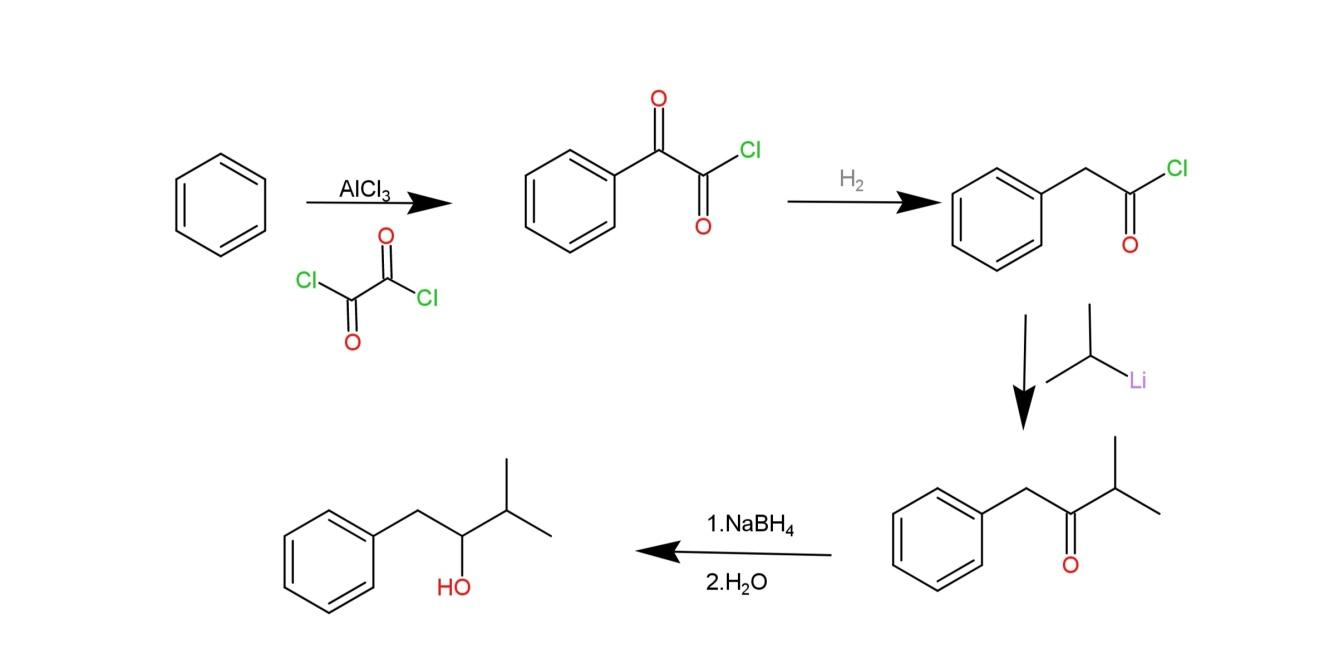
How to prepare 1-phenyl-3-methyl-2-butanol?
Answer
443.1k+ views
Hint: Aromatic compounds (benzene) can have carbon chain added through Friedal-crafts reactions. Organolithium reagents help in nucleophilic addition reactions. Sodium borohydrides are used as reducing agents for carbonyl compounds.
Complete answer:
We have been given to write about the preparation method of 1-phenyl-3-methyl-2-butanol. As the name suggests, this compound contains a benzene ring with a 4-carbon chain on the first carbon of benzene. This 4-carbon chain has a methyl group on carbon-3 and a hydroxyl group on carbon-2, which makes it a secondary alcohol.
The preparation of 1-phenyl-3-methyl-2-butanol involves friedel-craft acylation of benzene employing a catalyst used to synthesis organic compounds called oxalyl chloride

Hence, through the above reaction we can prepare 1-phenyl-3-methyl-2-butanol.
Note:
Friedel-crafts acylation is used in this reaction because; we have to obtain a secondary alcohol, which can be formed from the acyl group. While, friedel-crafts alkylation will be involved if we have to add up only a carbon chain to the benzene ring.
Complete answer:
We have been given to write about the preparation method of 1-phenyl-3-methyl-2-butanol. As the name suggests, this compound contains a benzene ring with a 4-carbon chain on the first carbon of benzene. This 4-carbon chain has a methyl group on carbon-3 and a hydroxyl group on carbon-2, which makes it a secondary alcohol.
The preparation of 1-phenyl-3-methyl-2-butanol involves friedel-craft acylation of benzene employing a catalyst used to synthesis organic compounds called oxalyl chloride

Hence, through the above reaction we can prepare 1-phenyl-3-methyl-2-butanol.
Note:
Friedel-crafts acylation is used in this reaction because; we have to obtain a secondary alcohol, which can be formed from the acyl group. While, friedel-crafts alkylation will be involved if we have to add up only a carbon chain to the benzene ring.
Latest Vedantu courses for you
Grade 11 Science PCM | CBSE | SCHOOL | English
CBSE (2025-26)
School Full course for CBSE students
₹41,848 per year
Recently Updated Pages
Express the following as a fraction and simplify a class 7 maths CBSE

The length and width of a rectangle are in ratio of class 7 maths CBSE

The ratio of the income to the expenditure of a family class 7 maths CBSE

How do you write 025 million in scientific notatio class 7 maths CBSE

How do you convert 295 meters per second to kilometers class 7 maths CBSE

Write the following in Roman numerals 25819 class 7 maths CBSE

Trending doubts
State and prove Bernoullis theorem class 11 physics CBSE

What are Quantum numbers Explain the quantum number class 11 chemistry CBSE

Write the differences between monocot plants and dicot class 11 biology CBSE

Who built the Grand Trunk Road AChandragupta Maurya class 11 social science CBSE

1 ton equals to A 100 kg B 1000 kg C 10 kg D 10000 class 11 physics CBSE

State the laws of reflection of light




